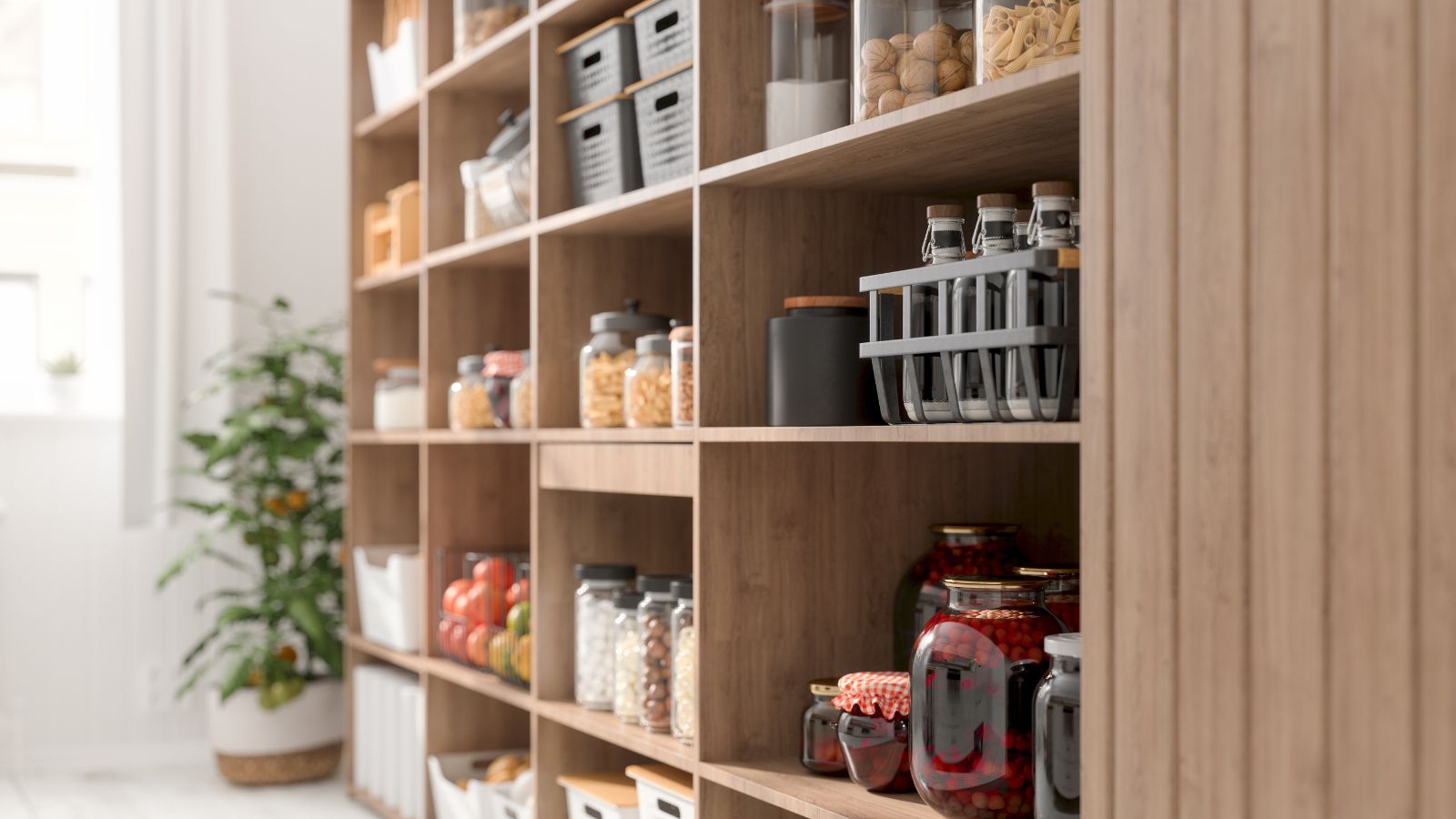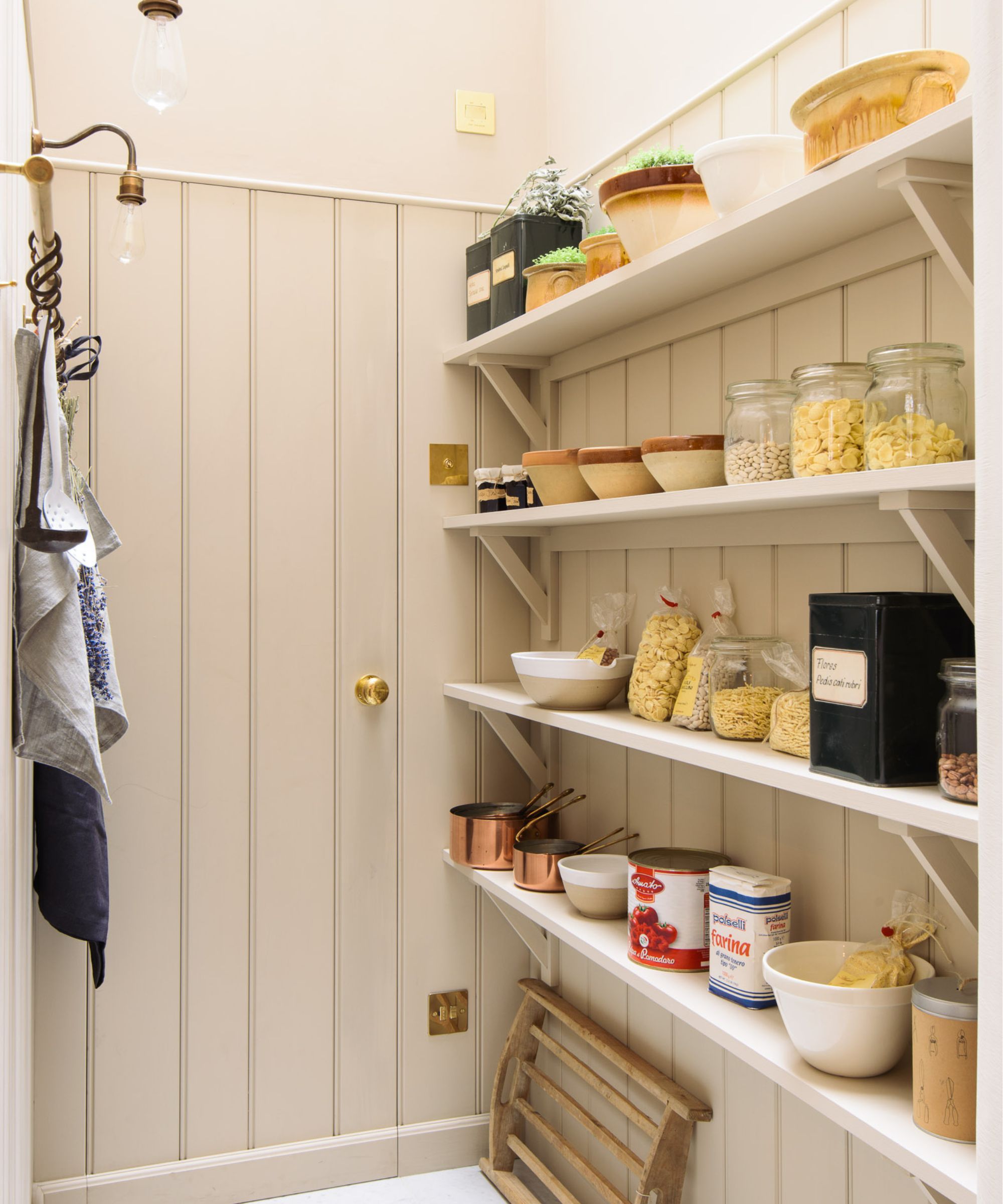
- 1. Take stock of what you’ve got
- 2. Group like-items into clear bins
- 3. Designate a central space for backstock (if you can)
- 4. Be savvy with where you stash things
- 5. Remove bulky packaging
- 6. Label everything
- 7. Think first in, first out
- 8. Make your freezer work harder
- 9. Utilize every inch of space
- 10. Keep a running list
- FAQs
Stocking up on things you use often is a sustainable and cost-effective tactic (assuming you have space to store it all, that is), but knowing how to organize your home after bulk buying groceries and household supplies is essential if you want to keep track of what you have.
Finding ways to stash surplus supplies out of sight – yet readily available – can be tricky, particularly if you’re organizing small spaces. The key is to establish practical storage ideas ahead of trip to the store, so you’re not tempted to buy more than your home can handle; the last thing you want to do is waste anything.
Whether you’re looking for stylish pantry storage ideas, how to organize cleaning supplies or space-saving ways to stash kitchen towels, toilet rolls and pet supplies, our experts have got you covered with their top tips, as well as a few zero-waste pantry restocking tricks to bear in mind for the future, too.
How to organize your home after bulk buying
While we’re all for bulk buying, it’s important not to get too carried away. As tempting as those store offers may be, you’ll need to be cautious about how much you’re bringing home, particularly if you're organizing a small pantry.
1. Take stock of what you’ve got

Even for the most experienced bulk-buy shoppers, walking into the store without a plan is never a good idea. It’s great to save money on items you use often, but if you don’t have space to store excess supplies, you’ll wind up with a cluttered home – and likely a lot of waste, too.
‘Before you head to the store, take inventory of your current backstock ( get rid of anything past its shelf-life) and assess how much room you’ll need to store those items. I like to set myself ‘space limits’; when that space fills up, I know not to buy anymore – regardless of how good the offer is,' says Gabriella Dyson, Head of Solved, Homes & Gardens.
2. Group like-items into clear bins
Just like you would when organizing a pantry, group bulk-buy items according to their use or purpose and corral them into transparent, labeled containers.
Design expertise in your inbox – from inspiring decorating ideas and beautiful celebrity homes to practical gardening advice and shopping round-ups.
‘It keeps things neat and makes it so much easier to find what you need, plus you can quickly spot when you’re starting to overstock,' says professional organizer Michelle Urban, founder of The Organized House.
Opt for generic categories, such as ‘laundry products’, ‘pantry staples’ or household supplies’, rather than designating exact brands or items. The easier your system, the more likely you are to stick to it, plus it allows for any changes in shopping habits.
3. Designate a central space for backstock (if you can)
Ideally you’d have a central space for all your backstock, a ‘one-stop shop’ for when you run out of things. Assign a kitchen, utility or pantry cabinet to overflow items or set up sturdy shelving units when organizing a garage.
‘Be sure to choose a place in your home that is temperature controlled or doesn't have major temperature swings. You also want to be mindful about humidity levels; adding a dehumidifier may help solve any moisture problems, making it safer to store items long-term,' advises professional organizer Lauren Saltman, Founder of Living. Simplified.
4. Be savvy with where you stash things

Depending how much space you have – and how much bulk you buy – you may need to create a few separate storage areas around the house. Assign groups of like-items a location based on what they are and where you’re likely to need them; paper towels and cleaning supplies on shelves in your utility room ideas, toiletries in a linen closet or bathroom storage ideas, and dried goods as part of organizing deep pantry shelves, for example.
If you're organizing a small kitchen without a pantry, or you’re yet to create a utility zone in your home, you’ll need to think outside the box when it comes to storing backstock, or outside the room, in this case.
‘Just because there’s no obvious space for surplus doesn’t mean there isn’t any. Take a good look around your home. Is there space under the bed going to spare? Baskets on top of a cabinet? Stackable drawers in the bottom of a closet? Once you lose the notion that certain items have to be stored in certain places (pantry items in the kitchen, toiletries in the bathroom etc), all manner of opportunities open up,' says Michelle.
5. Remove bulky packaging
Removing (and recycling) packets and jars where possible is a great space-saver and decanting where you can into airtight containers (the OXO Good Grips POP 5-Piece set from the Container Store is a good starting point) will keep food items fresh and cleaning supplies secure. Clear versions will make it much easier to locate what you need, plus you’ll be able to see clearly when essentials are running low.
6. Label everything
‘Labeling shelves and containers with contents and, where applicable, expiration dates, can turn the hassle of hunting for what you need into a thing of the past. This is especially handy for items tucked away in opaque containers or those stored in spots that require a bit of a reach,' says Michelle.
Preferences can change, so opting for chalkboard label tape from The Container Store is good way of futureproofing your organizational system – that way you need only update the labels, rather than the whole container.
7. Think first in, first out

‘Be sure to pay attention to expiration dates when storing your surplus’, says Lauren. ‘If you’re storing anything perishable, ake the time to position newly-bought items at the back or bottom of your bin so you use the older items first’.
This is the way food is arranged in supermarkets, to reduce the risk of items expiring before customers have bought them. It’s a handy waste-saving hack worth bearing in mind when organizing your refrigerator in general.
8. Make your freezer work harder
In general fresh fruit and veggies store better outside of the fridge (try an open wicker floor basket, so you can see when stocks are running low), but if you’ve overdone it on your bulk buying, you’ll need to put your freezer to work. Divide them into usable portions, so you can defrost the perfect amount every time.
You can freeze all manner of fresh produce to prolong its shelf life, from milk and meat, to bread and butter, as well the leftovers from any bulk-cooking you’re doing, too. Decant into stackable containers or use freezer bags and freeze them flat; this gives you the option to stack vertically when organizing a chest freezer to maximize space.
9. Utilize every inch of space

From carousels and risers to under-shelf baskets, investing in pantry organizers can make a huge difference to the amount of bulk items you can store – and how efficiently you store them.
‘Utilizing vertical space with shelves, stackable bins, and over-the-door organizers can dramatically increase your bulk storage capacity, freeing up precious real estate in closets and cabinets for items you use day-to-day,' says Michelle.
If you’ve maxed out on vertical space, you can always use the floor, but be selective about what you store there – especially if there’s potential for pests. Anything securely packaged, such as canned goods, juice boxes or soda are a safe bet. Be cautious about storing anything hazardous within easy reach if you’re organizing a home with children in mind, or pets.
10. Keep a running list
‘Keeping a simple list on your fridge or a digital spreadsheet of what you have on hand can revolutionize how you shop and use your supplies. Update it as you deplete items and after each bulk purchase. This way, you'll always know what you have, avoiding unnecessary purchases and ensuring you never run out of the essentials,' says Michelle.
FAQs
What is the best way to store bulk food?
The last thing you want is for items to spoil, so an efficient storage system is essential when it comes to storing food long term.
Start by choosing somewhere cool and dry, such as a pantry or garage, and add shelving units and organizers to maximize storage space. If you’re buying from the bulk bins, decant loose items into plastic airtight containers to keep them fresh and pests at bay. Assign fresh produce for the week ahead, and divide the rest into usable portions, ready for the freezer.
Whether fresh, dried or frozen, implement the ‘FIFO’ system across all food storage, so goods that expire sooner are closer to the front for easier access.
We know those offers are tempting, but having a really good understanding of the amount of things you can physically fit in your home is the key to achieving a sustainable bulk-buy system. So make a list – and stick to it!

For 10 years, Tara King worked as a Content Editor in the magazine industry, before leaving to become freelance, covering interior design, wellbeing, craft and homemaking. As well as writing for Ideal Home, Style at Home, Country Homes & Interiors, Tara’s keen eye for styling combined with a passion for creating a happy – and functional – family home has led to a series of organization and cleaning features for H&G.
